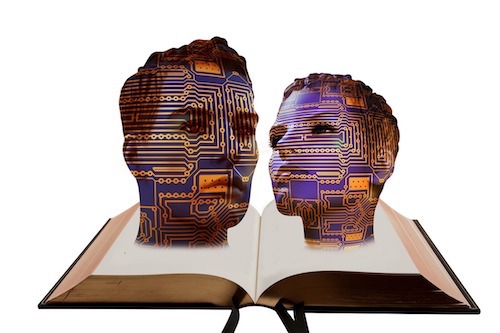In 2013, Carl Frey, an economist and Oxford Martin Citi Fellow at Oxford University, and Michael Osborne, Dyson Associate Professor in Machine Learning at the Oxford University, predicted jobs that would be replaced by Artificial Intelligence (AI) in “The Future of Employment: How Susceptible are Jobs to Computerisation?” They examined 702 jobs to calculate their probability of being computerized and estimated that “about 47 percent of total U.S. employment is at risk.”
The researchers also state that perceptive, creative, and social tasks are less likely to be superseded by robots. So, fortunately, publishing-related jobs seem less likely to be replaced by AI. For example, editors’ odds of being replaced is 0.055 and 140th out of 702 jobs. Graphic designers’ odds of being replaced is 0.082 and 161st, meaning book cover designers’ jobs may also be less threatened by AI.
However, when I read “Judging a Book by its Cover,” issued in 2016 by Brian Iwana et. al at the Department of Advanced Information Technology at Kyushu University, I felt slightly uneasy about the future of book cover designers. The researchers obtained 137,788 book cover images and genre information from Amazon. Then they had a deep Convolutional Neural Network (CNN) learn 90 percent of those cover images and the relationships between the genres. The remaining 10 percent of the images and information was used to examine the accuracy of the CNN’s ability to match covers and genres.
The results revealed that the accuracy of CNN’s first choice was 20 percent and that it increased to 40 percent if extended to the third choice. The researchers concluded that “classification of book cover designs is possible, although a very difficult task.” In addition, CNN showed the characteristics and tendencies of each genre’s book covers. One of the genres that CNN most accurately guessed was “Travel,” because those book covers usually use large landscape photographs. Meanwhile, “Biographies & Memoirs” and “History” tended to be mixed up. This is understandable because most biographies and memoirs also fall into the “History” category at Amazon, and may be hard to distinguish by even human eyes at first glance.
So what clues does CNN rely on? The researchers categorized three matters: color, objects, and text. For example, CNN associated white with “Self-help,” and dark colors for “Science Fiction & Fantasy.” If two people stood in close proximity, CNN guessed “Romance.” If people were illustrated, it predicted “Comics & Graphic Novels.” While “Mystery, Thriller & Suspense” tended to have a similar color palette and image content to “Romance” and “Science Fiction & Fantasy,” CNN distinguished them by their texts; “Mystery, Thriller & Suspense” books usually employ large, overlaid sans serif text. In fact, Jason van Gumster, an author based in Atlanta, Georgia, analyzes relationships between book covers and genres with Python code, GIMP, and Amazon API. He has found that “‘Mysteries, Thrillers, and Suspense’ titles use typography all over the cover.” Furthermore, “Mystery, Thriller & Suspense” covers use a large font size for titles, and those large fonts seem to help CNN’s accuracy. The genre that CNN most accurately predicted was “Test Preparation,” which contains large and short words. However, CNN does not seem to be able to read and understand words, because it mistook one book titled Fat as “Test Preparation,” which actually belonged in the “Medical Books” or “Health, Fitness & Dieting” category.
So what if the accuracy of book prediction and drawing or painting AI improves? Although design is a creative activity, AI could create book covers if future sophisticated book prediction AI learned more book covers and genres, succeeded in quantifying them, and then, drawing or painting AI used the data to design book covers. I want to believe that I am being overly-anxious. Book covers not only function to predict genre, but also to hook in potential readers. Eye-catching images do not always agree with their genres. For instance, when I encountered Made to Stick: Why Some Ideas Survive and Others Die, I could not help touching the bumpy duct tape image, and unconsciously picked up, browsed, and, finally, purchased it (its content was actually interesting and helpful).
The relationship between human beings and book covers is not mechanical enough to quantify, so the hope is that book genre prediction AI will not threaten book cover designers but instead aid them. For example, when we look for comp titles, it would be helpful to be able to sort through tremendous amounts of books. In the future, we may consider AI friendliness when developing cover design concept. Alternatively, we could create two patterns of covers: one for physical bookstores and one for online stores. Brick and mortar bookstores involve not just sight but also touch, while many online shoppers have already determined what book they are aiming for and jump directly to a certain genre. Therefore, covers for online shopping could be optimized for AI. Developing AI that predicts genre by cover would not deprive book cover designers of their job, but could provide them with more opportunities to refine and make good use of their skills.

